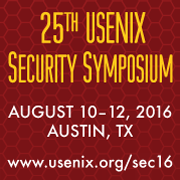
Get more
Help Promote graphics!
Vasileios P. Kemerlis, Michalis Polychronakis, and Angelos D. Keromytis, Columbia University
Return-to-user (ret2usr) attacks redirect corrupted kernel pointers to data residing in user space. In response, several kernel-hardening approaches have been proposed to enforce a more strict address space separation, by preventing arbitrary control flow transfers and dereferences from kernel to user space. Intel and ARM also recently introduced hardware support for this purpose in the form of the SMEP, SMAP, and PXN processor features. Unfortunately, although mechanisms like the above prevent the explicit sharing of the virtual address space among user processes and the kernel, conditions of implicit sharing still exist due to fundamental design choices that trade stronger isolation for performance.
In this work, we demonstrate how implicit page frame sharing can be leveraged for the complete circumvention of software and hardware kernel isolation protections. We introduce a new kernel exploitation technique, called return-to-direct-mapped memory (ret2dir), which bypasses all existing ret2usr defenses, namely SMEP, SMAP, PXN, KERNEXEC, UDEREF, and kGuard. We also discuss techniques for constructing reliable ret2dir exploits against x86, x86-64, AArch32, and AArch64 Linux targets. Finally, to defend against ret2dir attacks, we present the design and implementation of an exclusive page frame ownership scheme for the Linux kernel that prevents the implicit sharing of physicalmemory pages with minimal runtime overhead.
Open Access Media
USENIX is committed to Open Access to the research presented at our events. Papers and proceedings are freely available to everyone once the event begins. Any video, audio, and/or slides that are posted after the event are also free and open to everyone. Support USENIX and our commitment to Open Access.
author = {Vasileios P. Kemerlis and Michalis Polychronakis and Angelos D. Keromytis},
title = {ret2dir: Rethinking Kernel Isolation},
booktitle = {23rd USENIX Security Symposium (USENIX Security 14)},
year = {2014},
isbn = {978-1-931971-15-7},
address = {San Diego, CA},
pages = {957--972},
url = {https://www.usenix.org/conference/usenixsecurity14/technical-sessions/presentation/kemerlis},
publisher = {USENIX Association},
month = aug
}














connect with us